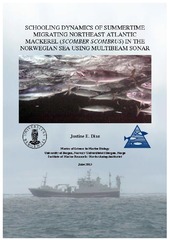Schooling dynamics of summertime migrating Northeast Atlantic mackerel (Scomber scombrus) in the Norwegian Sea using multibeam sonar
Master thesis
Permanent lenke
http://hdl.handle.net/1956/7189Utgivelsesdato
2013-05-31Metadata
Vis full innførselSamlinger
Sammendrag
Pelagic fish in the Norwegian Sea perform seasonal migrations from overwintering, via spawning, to feeding grounds. Northeast Atlantic (NEA) mackerel (Scomber scombrus) are highly migratory, fast- swimming, and an obligate schooling fish. The schooling dynamics of NEA mackerel in nature is largely unknown because they lack a swimbladder, resulting in a weak acoustic signature, and therefore are difficult to detect in the summer when swimming in loose school formations. However, high frequency omnidirectional SONAR (SOund Navigation And Ranging) is capable of detecting NEA mackerel in the acoustic echosounder blind zone close to the surface. Acoustic, biological, and temperature data were used to study the schooling dynamics of NEA mackerel in relation to temperature, zooplankton abundance and density of conspecifics in four geographically separate regions of the Norwegian Sea during summer. These results show that there were regional differences in fish size, swimming speed and direction, school depth, temperature and zooplankton abundance. The thermocline depth had a profound influence on the depth distribution of schools throughout the Norwegian Sea during summer. NEA mackerel were consistently found shallower than 40 m depth where the temperature was at least 6° C. The fish generally swam north except for in the SW region, coinciding well with prevailing current directions. Fish were significantly larger in the north than in the south, and plankton abundance was higher in the west than in the east. The observed school dynamics in relation to abiotic and biotic factors are explained in terms of the ecology of NEA mackerel during the summer feeding migration.
